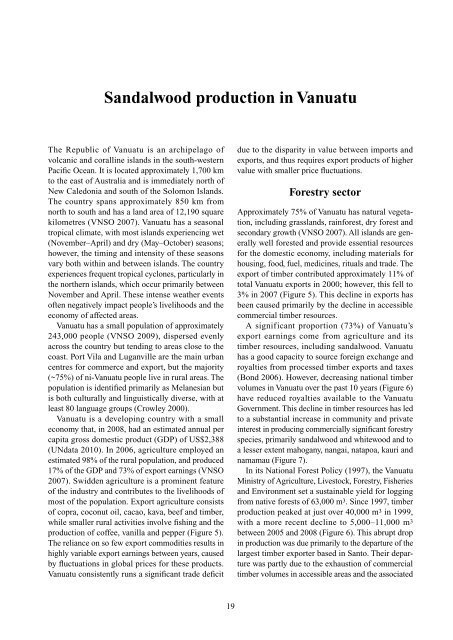Opportunities for the smallholder sandalwood industry in ... - ACIAR
Opportunities for the smallholder sandalwood industry in ... - ACIAR
Opportunities for the smallholder sandalwood industry in ... - ACIAR
Create successful ePaper yourself
Turn your PDF publications into a flip-book with our unique Google optimized e-Paper software.
Sandalwood production <strong>in</strong> Vanuatu<br />
The Republic of Vanuatu is an archipelago of<br />
volcanic and corall<strong>in</strong>e islands <strong>in</strong> <strong>the</strong> south-western<br />
Pacific Ocean. It is located approximately 1,700 km<br />
to <strong>the</strong> east of Australia and is immediately north of<br />
New Caledonia and south of <strong>the</strong> Solomon Islands.<br />
The country spans approximately 850 km from<br />
north to south and has a land area of 12,190 square<br />
kilometres (VNSO 2007). Vanuatu has a seasonal<br />
tropical climate, with most islands experienc<strong>in</strong>g wet<br />
(November–April) and dry (May–October) seasons;<br />
however, <strong>the</strong> tim<strong>in</strong>g and <strong>in</strong>tensity of <strong>the</strong>se seasons<br />
vary both with<strong>in</strong> and between islands. The country<br />
experiences frequent tropical cyclones, particularly <strong>in</strong><br />
<strong>the</strong> nor<strong>the</strong>rn islands, which occur primarily between<br />
November and April. These <strong>in</strong>tense wea<strong>the</strong>r events<br />
often negatively impact people’s livelihoods and <strong>the</strong><br />
economy of affected areas.<br />
Vanuatu has a small population of approximately<br />
243,000 people (VNSO 2009), dispersed evenly<br />
across <strong>the</strong> country but tend<strong>in</strong>g to areas close to <strong>the</strong><br />
coast. Port Vila and Luganville are <strong>the</strong> ma<strong>in</strong> urban<br />
centres <strong>for</strong> commerce and export, but <strong>the</strong> majority<br />
(~75%) of ni-Vanuatu people live <strong>in</strong> rural areas. The<br />
population is identified primarily as Melanesian but<br />
is both culturally and l<strong>in</strong>guistically diverse, with at<br />
least 80 language groups (Crowley 2000).<br />
Vanuatu is a develop<strong>in</strong>g country with a small<br />
economy that, <strong>in</strong> 2008, had an estimated annual per<br />
capita gross domestic product (GDP) of US$2,388<br />
(UNdata 2010). In 2006, agriculture employed an<br />
estimated 98% of <strong>the</strong> rural population, and produced<br />
17% of <strong>the</strong> GDP and 73% of export earn<strong>in</strong>gs (VNSO<br />
2007). Swidden agriculture is a prom<strong>in</strong>ent feature<br />
of <strong>the</strong> <strong><strong>in</strong>dustry</strong> and contributes to <strong>the</strong> livelihoods of<br />
most of <strong>the</strong> population. Export agriculture consists<br />
of copra, coconut oil, cacao, kava, beef and timber,<br />
while smaller rural activities <strong>in</strong>volve fish<strong>in</strong>g and <strong>the</strong><br />
production of coffee, vanilla and pepper (Figure 5).<br />
The reliance on so few export commodities results <strong>in</strong><br />
highly variable export earn<strong>in</strong>gs between years, caused<br />
by fluctuations <strong>in</strong> global prices <strong>for</strong> <strong>the</strong>se products.<br />
Vanuatu consistently runs a significant trade deficit<br />
due to <strong>the</strong> disparity <strong>in</strong> value between imports and<br />
exports, and thus requires export products of higher<br />
value with smaller price fluctuations.<br />
Forestry sector<br />
Approximately 75% of Vanuatu has natural vegetation,<br />
<strong>in</strong>clud<strong>in</strong>g grasslands, ra<strong>in</strong><strong>for</strong>est, dry <strong>for</strong>est and<br />
secondary growth (VNSO 2007). All islands are generally<br />
well <strong>for</strong>ested and provide essential resources<br />
<strong>for</strong> <strong>the</strong> domestic economy, <strong>in</strong>clud<strong>in</strong>g materials <strong>for</strong><br />
hous<strong>in</strong>g, food, fuel, medic<strong>in</strong>es, rituals and trade. The<br />
export of timber contributed approximately 11% of<br />
total Vanuatu exports <strong>in</strong> 2000; however, this fell to<br />
3% <strong>in</strong> 2007 (Figure 5). This decl<strong>in</strong>e <strong>in</strong> exports has<br />
been caused primarily by <strong>the</strong> decl<strong>in</strong>e <strong>in</strong> accessible<br />
commercial timber resources.<br />
A significant proportion (73%) of Vanuatu’s<br />
export earn<strong>in</strong>gs come from agriculture and its<br />
timber resources, <strong>in</strong>clud<strong>in</strong>g <strong>sandalwood</strong>. Vanuatu<br />
has a good capacity to source <strong>for</strong>eign exchange and<br />
royalties from processed timber exports and taxes<br />
(Bond 2006). However, decreas<strong>in</strong>g national timber<br />
volumes <strong>in</strong> Vanuatu over <strong>the</strong> past 10 years (Figure 6)<br />
have reduced royalties available to <strong>the</strong> Vanuatu<br />
Government. This decl<strong>in</strong>e <strong>in</strong> timber resources has led<br />
to a substantial <strong>in</strong>crease <strong>in</strong> community and private<br />
<strong>in</strong>terest <strong>in</strong> produc<strong>in</strong>g commercially significant <strong>for</strong>estry<br />
species, primarily <strong>sandalwood</strong> and whitewood and to<br />
a lesser extent mahogany, nangai, natapoa, kauri and<br />
namamau (Figure 7).<br />
In its National Forest Policy (1997), <strong>the</strong> Vanuatu<br />
M<strong>in</strong>istry of Agriculture, Livestock, Forestry, Fisheries<br />
and Environment set a susta<strong>in</strong>able yield <strong>for</strong> logg<strong>in</strong>g<br />
from native <strong>for</strong>ests of 63,000 m 3 . S<strong>in</strong>ce 1997, timber<br />
production peaked at just over 40,000 m 3 <strong>in</strong> 1999,<br />
with a more recent decl<strong>in</strong>e to 5,000–11,000 m 3<br />
between 2005 and 2008 (Figure 6). This abrupt drop<br />
<strong>in</strong> production was due primarily to <strong>the</strong> departure of <strong>the</strong><br />
largest timber exporter based <strong>in</strong> Santo. Their departure<br />
was partly due to <strong>the</strong> exhaustion of commercial<br />
timber volumes <strong>in</strong> accessible areas and <strong>the</strong> associated<br />
19
















